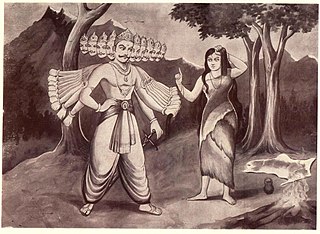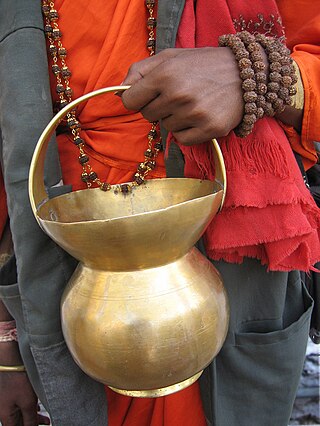
The Ramayana, also known as Valmiki Ramayana, as traditionally attributed to Valmiki, is a smriti text from ancient India, one of the two important epics of Hinduism known as the Itihasas, the other being the Mahabharata. The epic narrates the life of Rama, a prince of Ayodhya in the kingdom of Kosala. The epic follows his fourteen-year exile to the forest urged by his father King Dasharatha, on the request of Rama's stepmother Kaikeyi; his travels across forests in the Indian subcontinent with his wife Sita and brother Lakshmana; the kidnapping of Sita by Ravana, the king of Lanka, that resulted in war; and Rama's eventual return to Ayodhya along with Sita to be crowned king amidst jubilation and celebration.

Ravana, mythological demon-king of the island of Lanka, is the chief antagonist in the Hindu epic Ramayana. In the Ramayana, Ravana is described as the eldest son of sage Vishrava and Kaikasi. He abducted Lord Rama's wife, Sita, and took her to his kingdom of Lanka, where he held her in the Ashoka Vatika. Lord Rama, with the support of vanara King Sugriva and his army of vanaras, launched a rescue operation for Sita against Ravana in Lanka. Ravana was subsequently slain, and Rama rescued his beloved wife Sita.

Rākshasa are a race of usually malevolent beings prominently featured in Hinduism, Buddhism, Jainism and Folk Islam. They reside on Earth but possess supernatural powers, which they usually use for evil acts such as disrupting Vedic sacrifices or eating humans.

In the Hindu epic Ramayana, Maricha, or Mareecha is a rakshasha, who was killed by Rama, the hero of the epic and an avatar of Vishnu. He is mentioned as an ally of Ravana, the antagonist of the epic. His most notable exploit is his role in the kidnapping of Sita, Rama's wife. His son Kalanemi was killed by Hanuman.

In Hinduism, Vanara are either monkeys, apes, or a race of forest-dwelling people.

Meghanada, also referred to by his epithet Indrajita, according to Hindu texts, was the eldest son of Ravana and the crown prince of Lanka, who conquered Indraloka (Heaven). He is regarded as one of the greatest warriors in Hindu texts. He is a major character mentioned in the Indian epic Ramayana. Meghanada is the central character in Bengali ballad Meghnad Badh Kavya. He played an active role in the great war between Rama and Ravana. He acquired many kinds of celestial weapons from his Guru Shukra. His most prominent feat is having defeated the devas in heaven. Using the Brahmastra, Indrajita killed 670 million vanaras in a single day; nearly exterminating the entirety of the vanara race. No warrior had ever achieved this statistical feat before in the Ramayana. He is the only warrior in the entire Ramayana to defeat both Rama and Lakshmana twice while they were both armed by making them unconscious in a battle with the help of astras and sorcery and finally got killed by Lakshmana. He was said to be more powerful and superior warrior than his father Ravana by Brahma and Agastya.

Vali also known as Bali, was a vanara and the king of Kishkindha in the Hindu epic Ramayana. He was the husband of Tara, the son of Indra, the elder brother of Sugriva, and the father of Angada.

Ramcharitmanas, is an epic poem in the Awadhi language, composed by the 16th-century Indian bhakti poet Tulsidas. It has many inspirations, the primary being the Ramayana of Valmiki.

Vibhishana is the younger brother of Ravana, the King of Lanka, in the ancient Indian epic Ramayana. Though a rakshasa himself, Vibhishana turned his back on Ravana, and defected to Rama's side, owing to his dharma. After Rama defeated Ravana, the former crowned Prince Vibhishana as the King of Lanka before returning to Ayodhya.

Kumbhakarna is a powerful rakshasa and younger brother of Ravana from the Hindu epic Ramayana. Despite his gigantic size and appetite, he is described as a virtuous character and a great warrior in Hindu texts. He is said to have slaughtered 8,000 vanaras over the course of Rama's mission to rescue Sita.

Buddhism in Thailand is largely of the Theravada school, which is followed by roughly 93.4 percent of the population. Thailand has the second largest Buddhist population in the world, after China, with approximately 64 million Buddhists. Buddhism in Thailand has also become integrated with folk religion (Bon), Hinduism from millennia of Indian influence, and Chinese religions from the large Thai Chinese population. Buddhist temples in Thailand are characterized by tall golden stupas, and the Buddhist architecture of Thailand is similar to that in other Southeast Asian countries, particularly Cambodia and Laos, with which Thailand shares cultural and historical heritages. Thai Buddhism also shares many similarities with Sri Lankan Buddhism. Thailand, Cambodia, Myanmar, Sri Lanka and Laos are countries with Theravada Buddhist majorities.

Hinduism is one of Sri Lanka's oldest religions, with temples dating back over 2,000 years. As of 2011, Hindus made up 12.6% of the Sri Lankan population. They are almost exclusively Tamils, except for small immigrant communities from India and Pakistan.

Vedavati is the previous birth of the goddess Sita in Hindu mythology. She is the Goddess of the Vedas, who embodies and imparts all knowledge and wisdom. An avatar of the goddess of prosperity, Lakshmi.

Kamandalu, kamandal, or kamandalam is an oblong water pot, originating from the Indian subcontinent, made of a dry gourd (pumpkin) or coconut shell, metal, wood of the Kamandalataru tree, or from clay, usually with a handle and sometimes with a spout. Hindu ascetics or yogis often use it for storing drinking water. The water-filled kamandalu, which is invariably carried by ascetics, is stated to represent a simple and self-contained life.

Seetha Amman Temple, or Seetha Eliya Seethai Amman Thirukkovil, also known as Ashok Vatika Sita Temple, is an ancient Vaishnavite Hindu temple located in the Nuwara Eliya District of Central Sri Lanka. The temple's folklore is deeply connected to the Hindu epic, the Ramayana. According to the epic, after Sita was abducted by King Ravana of Lanka, she was brought to this location. Ravana sought vengeance against Rama and Lakshmana to avenge the disrespect shown to his sister, Shurpanakha.
The Adbhuta Ramayana is a Śāktaḥ Sanskrit work. It is considerably more obscure than both the Valmiki Ramayana as well as Tulsidas’ Awadhi version entitled Ramacharitamanasa, northern India's most popular version of the Ramayana story.

Akalabodhana or Akal Bodhan is the worship of Durga—an incarnation of Devi—in the month of Ashvin, an uncustomary time for commencement of her worship.

Sri Rama Pattabhishekam is a 1978 Indian Telugu-language Hindu mythological film directed and produced by N. T. Rama Rao under Ramakrishna Cine Studios banner. Based on the Ramayana, the film stars Rama Rao, Jamuna and Sangeeta, with music composed by Pendyala Nageswara Rao.